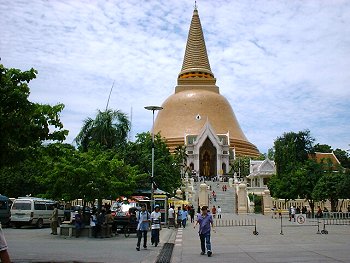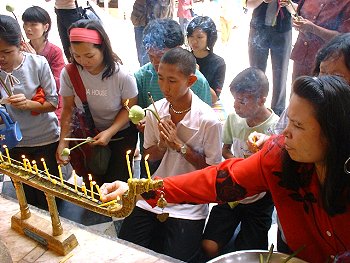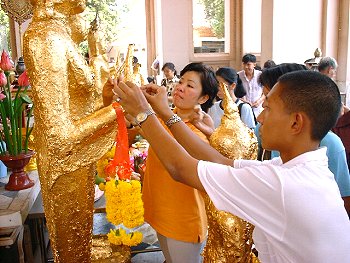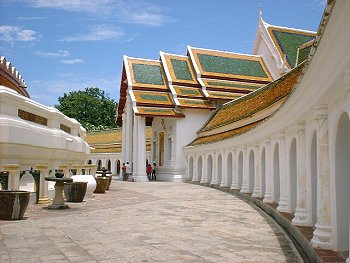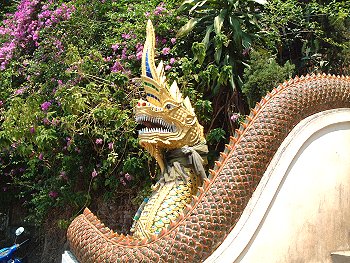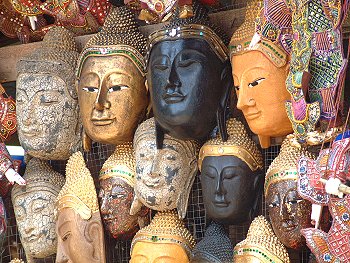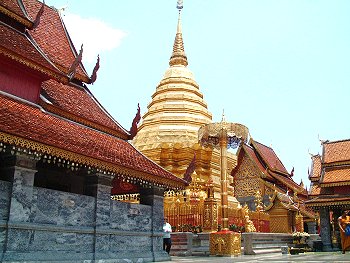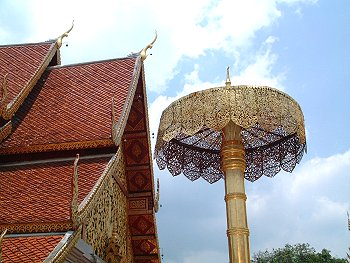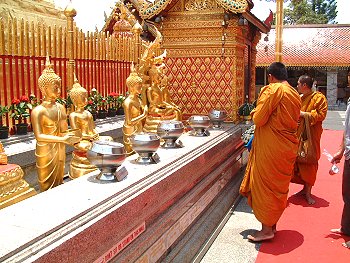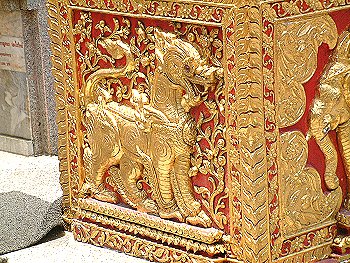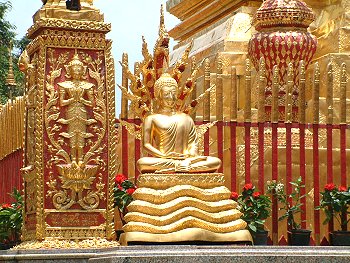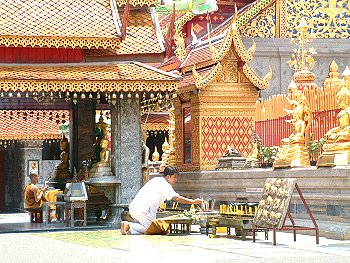Thai Temples Adapted from: Thai Street Food in my Area by Gor (Panrit "Gor" Daoruang) a Thai Teenager and his webite:
|
|---|
Beautiful Temples in Thailand
Thailand is a land of many beautiful Buddhist temples.


Left: Wat Phra Khaeo, Bangkok
Right: Wat Arun, Bangkok


Left: Phra Pathom Chedi, Nakhon Pathom
Right: Phrathat Phanom, Nakhon Pathom


Left: Phrathat Doi Kong Mu, Mae Hong Son
Right: Phrathat Hariphunchai, Lamphun


Left: Ancient Palace
Right: Prasat Hin Khao Phanom Rung, Buri Ram Buddhamonthon is located in Phutthamonthon District, Nakhon Pathom. It is the largest sacred places of Buddhism in Thailand, with an area of 1,000 acres. The idea to have Buddhamonthon as the center for Buddhist sacred place was initiated by Premier Field Marshall Phibulsongkhram in order to commemorate the 2500th anniversary of Buddhism, in 1957. He initiated the construction project of Buddha's precints called Phuttha Monthon. With the intention to make it the center of buddhist learning, many buildings were to be erected on this large consecrated piece of land.
The image was designed by Prof. Silpa Bhirasri in 1955 and was cast in 1981. The image is in the walking position. It is 17.358 meters high. His Majesty the King named this statue "Phra Si Sakaya Thosaphonlayan".

Magha Puja Day is one of the most important Buddhist celebrations which falls on the full moon day of the third lunar month (about last week of February or early of March).
This day marks the great four events that took place during Lord Buddha's lifetime, namely;
- 1250 Buddhist monks from different places came to pay homage to Lord Buddha at Valuwan Vihara in Rajgaha, the capital of Magaha State, each of his own initiative and without prior notification or appointment.
- all of them were the enlightened monks (or Arahantas)
- all of them had been individually ordained by Lord Buddha himself (Ehi Bhikkhu)
- They assembled on the full moon day of the third lunar month.
On the evening of that day, Lord Buddha gave the assembly a discourse "Ovadha Patimokha" laying down the principles of His Teachings summarised into three acts, i.e. to do good, to abstain from bad action and to purify the mind.
It was unclear as to when the Magha Puja Ceremony took place. However, in a guide book of ceremonies for the twelve months written by King Chulalongkorn (Rama V), it is said that,
"In the past, the Magha Puja was never performed, the ceremony has just been practised during the reign of King Mongkut (Rama IV)"
Having realized the significance of this day, King Rama IV ordered the royal Magha Puja Ceremony tobe performed in the Emerald Buddha Temple in 1851 and to be continued forever. Later the ceremony was widely accepted and performed throughout the kingdom. The day is declared as a public holiday so that people from all walks of life can go to the temple to make merit and perform other religious activities in the morning and to take part in the candlelit procession or "Wien Tien" in Thai in the evening.
At the same time, at this auspicious time, His Majesty the King will preside over the religious rites to mark the occasion at the Emerald Buddha Temple and will later lead hundreds of people in a candlelit procession held within the temple's compound.
In fact, the candlelit procession can be held at any time suitable to the public's convenience, either in the morning or in the evening. However, in Bangkok it will usually take place in the evening at about 8.00 p.m. and the procession will be led by Buddhist monks.
In general, most Buddhists are not aware of the Significance of this day. As a result, a number of people taking part in the ceremony may be less than on other days such as Visakha Puja or Asanha Puja Days. Even so Magha Puja Day carries an equal meaning to all Buddhists.
Phra Pathom Chedi
Phra Pathom Chedi is located in Muang District, Nakhon Pathom Province, 56 kilometers west of Bangkok. The chedi (stupa) rises more than 120 meters into the air with the radius of the base of 233.50 meters. The present chedi was built in the reign of King Mongkut (Rama IV) to cover the old one that is believed to have been built some 2,000 years ago. The temple that houses Phra Pathom Chedi is one of the six highest ranking royal temples.
When he was a monk, King Rama IV found an old chedi. It was an up-side down bowl shape with a 'prang' on top, very similar to SANCHI stupa of India. The restoration of the chedi did not start until Prince Mongkut became King Rama IV. It took 17 years to complete, during the reign of King Rama V. King Rama IV named the stupa "Phra Pathom Chedi" because this stupa appeared first in this land before any others. (Pathom means first) It is the largest pagoda in the world.
Pictures copyright: Nattawud Daoruang
Information from: "Thai Studies Through Games" Book 2 by Assist. Prof. Wadee Kheourai.Wat Phra That Doi Suthep 01
This temple is Chiang Mai's most important and visible landmark, and overlooks the city from its forested mountain backdrop. It is 15 kilometres from town, 3,520 feet above sea level, and dates from 1383. The temple is approached on foot by climbing a steep staircase comprising 290 steps. The less energetic may ascend by funicular rail cars. The temple's golden pagoda contains holy Buddha relics, and attracts Buddhist pilgrims from all over the world throughout the year.
This is a picture of me sitting at the bottom of the steps. I went there in the summer holidays in April 2002. I was walking up there and by time I got to the top, I was tired like a dog!


